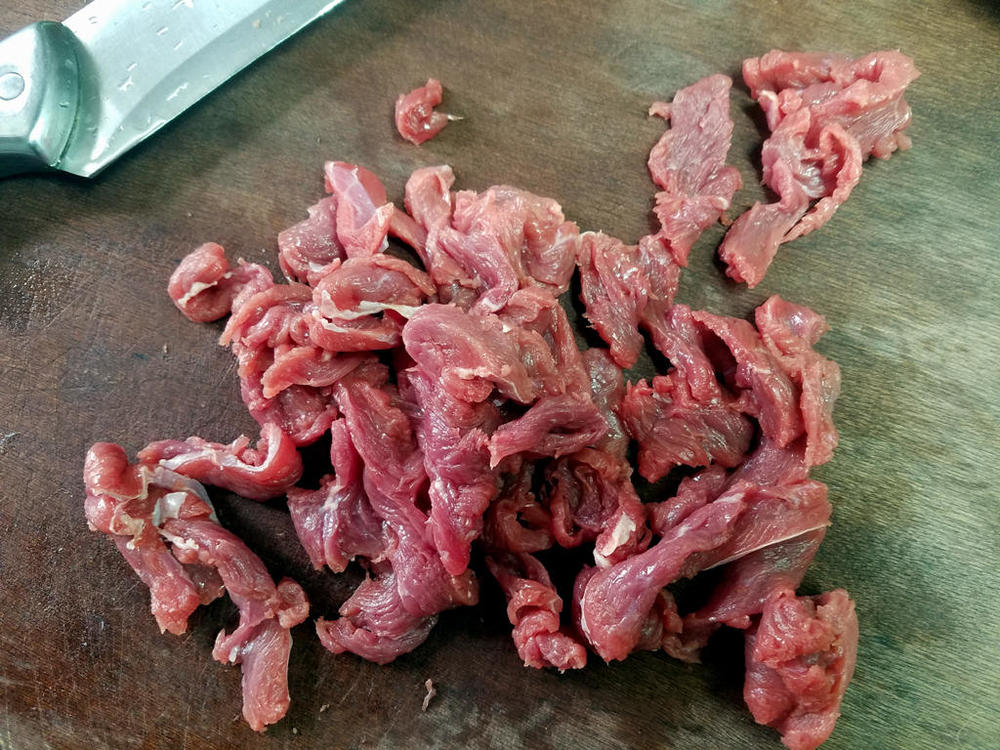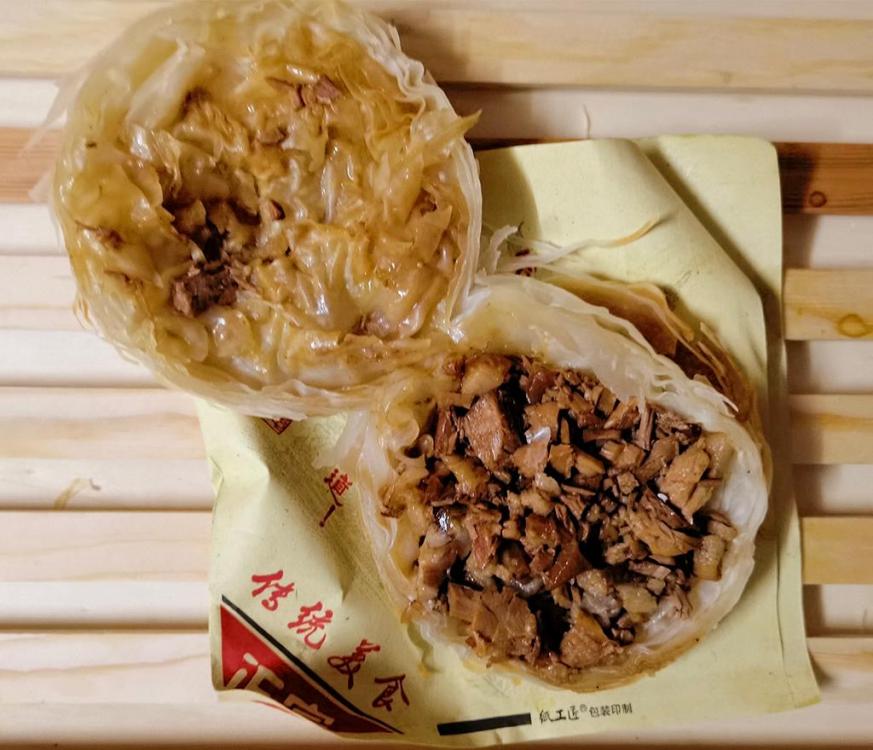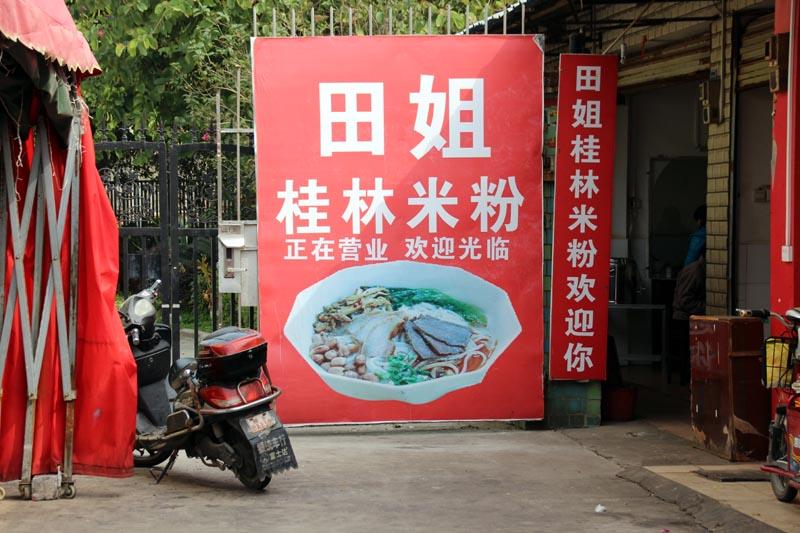Search the Community
Showing results for tags 'Chinese'.
-
Chinese banquet cooking is a specialty all to its self. Elaborately decorated platters, luxurious foods, special attention from the kitchen staff are what it's about. Head chefs can strut their stuff, especially when they're cooking for a table of 10. Any interesting experiences you can remember and share? Any other thoughts?
-
Might one of you kind people be able to provide me with instruction in the matter of making egg drop soup? Of course there is the essential technique of adding the egg to the stock, and I have no idea how to do it correctly, but I wouldn't be averse to hearing about how to make the underlying stock as well. I wish to do everything from scratch, and preferably without corn starch. Thank you very much.
-
There is now a growing movement calling for the banning of shark products. Of particular interest are the calls for the banning of sharks fin soup. There appear to be two reasons. The first is that much of the sharks fin is harvested by simply cutting off the fin and throwing the shark back into the ocean to die. The second is that some scientists are saying that shark numbers are being severely depleted. Any thoughts on this matter?
-
On the usually-dormant NYC.FOOD Usenet group, an amazingly high-traffic flamewar broke out recently regarding chopstick etiquette. Statements were made along the lines of "Chinese people never, ever eat rice with chopsticks" and "There are no chopsticks in Thailand." Having never paid much attention to chopstick etiquette (though I once saw a martial arts film wherein I learned that you don't leave your chopsticks standing up in a bowl of rice), I'd be interested in receiving some education. China? Japan? Southeast Asia? Mongolia? Toronto? What are the rules?
-
EATING IN TEMPLE ST. KOWLOON, HKG Night Market, Temple St. what a concept. A must for every visitor to HKG. More specifically, eating in Temple St. can be adventurous and fun. There are many small places, as well as outdoor seating by the sidewalk. Last trip, in November, we sat down in a hugh semi covered off-the-street kind-of-a-place. Picture, if you will a typical Mall type of a food court, except that these places are makeshift, look shanty like, and each kitchen has most seafood on display.Unlike the food courts here, they also have a few large tables with plastic chairs for themselves. Very few tables for two, the mone that are there tend to be on the sidewalk proper. Food here is inexpensive and good. Menus are in Chinese and a few of the kitchens have a photo-copied English menu with limited choices. You don't want that do you ? Large and small groups of people congregate in the these tables, order Heineken beer in large bottles, and an assortment of seafood appetisers - snails in large bowls. Order an assorted platter and the good folks of the kitchen associated with your table will drag in a small LPG bunsen burner on to yourtable. On top of it will be a round can like container with a partition in the middle. Each partition contains a different kind of a broth. Then comes the big platter, with slices of meats, live prawns in wooden skewers,and Chinese lettuce and Watercress. On the side, one has hot-oil (as in spicy), teriaki sauce, and yes, a bottle of Tabasco As the broths start bubbling, dip in the skewers of live prawns, or douse the watercress, or the other meats and seafood, eggs (of various birds). When you feel that the prawns or the vegetables are reasonably done, pull it out, dip it in your choice of sauces, and slug it down with Heineken. All this for 10-15USD per head. Bon Appetit.
-
The last couple of years we have celebrated new year's day with going out for dim sum in the International District. Honey Court used to be our favorite place, but I no longer recommend that place. Does any one have any other suggestions or favorites? Dim sum would be nice, but if we don't find a good place, we'll probably head out for some Pho instead. I've been wanting to try Saigon Bistro, anybody been there?
-
I was speaking to a friend recently. This person had lived in NYC for a period. I was asking her, which Cantonese chinese restaurants in NYC would she recommend for me. She told me that are none great Cantonese chinese restaurants in NYC. I should of preface by saying, that she left NYC around 7-8 years ago, but she still keeps in touch with friends in NYC. And she does know her Cantonese food(she's living in Hong Kong now). Does anyone here, who can recommend a top-notch NYC Cantonese restaurant for excellent food? I would appreciate any suggestions. ------ Steve
-
I'm interested in giving Chinese food a whirl. How do you guys prepare it? Any quick recipes for lo mein and Gen. Tso's chicken?
-
Does anyone know of a place in central jersey that does weddings for 150+ people, but serves Chinese food?
-
Anybody know what's in this mysterious Chinese sauce? What part of China is it from?
-
having a lot of trouble getting mine to taste like the ones at restaurants.
-
Dinner tonight was at a new Chinese restaurant called Lotus in West Orange. It was fair. We had watery cold(semi-warm actually) sesame noodles, Hunan chicken with an off taste and very good stir fried tofu with a hot sauce. The last time I went out for a really great Chinese dinner in NJ was at Sally Ling's in Westwood and they closed. Where do you like to go for Chinese food?
-
There seem to be several hundred varieties of soy sauce available out there. I have some basic idea of the differences but does anybody have the capacity to instruct us fully?
-
My brother who now lives in HK, is looking for a recipe for Lobster w/braised E-Fu Noodles. According to him, it's a classic Chinese dish popular in Hong Kong. And can also be ordered in Chinese restaurants in parts of North America. He's cooking 2 live lobsters on Saturday, & would like to make this recipe. I've checked all the Chinese cookbooks that I can find, but no luck in finding a recipe for this. Can anybody here help me. The major ingredients for this dish are lobster, chicken consomme/stock, E-Fu noodles(Chinese egg noodles), and ginger & onions. Thanks for any help. ____ Steve
-
When should I use one as opposed to the other? I've been defaulting to the shaoxing, but I recently picked up a cheap bottle of michiu to try out.
-
Hi ! On this forum, there is an overwhelming amount of information on individual regional dishes but I have not found any discussion concerning the combination of these dishes to form menus. Maybe I haven’t looked hard enough and would be quite happy if someone would provide a link. If not, perhaps it would be interesting to try to see what regional or inter-regional menus could look like in terms of balance (color, texture, taste, etc.). What "rules" do people use? Recently, I have tried to put together menus which reflect a gastronomic tour of the regional cuisines, limiting myself to the four directions, even though I know that it is more complicated than that. Here are my recent menus; please correct my Chinese which is not very strong. Any comments, corrections or suggestions would be most helpful. Thanks Menu 1 for 9 people Appetizer (West?): ( 羅 家 核 桃 ) Fire-Dried Walnuts West: ( 糖 醋 小 黃 瓜 ) Sweet and Tangy Cucumber Pickles South: ( 炸 子 鸡 ) Braised crispy (fried) chicken with prawn crackers West: ( 陈 皮 牛 肉 ) Orange Peel Beef East: ( 茄 子 塞 肉 ) Stuffed Eggplant North (also West): ( 酸 辣 汤 ) Hot sour soup Menu 2 for 8 people Appetizer (West?): ( 羅 家 核 桃 ) Fire-Dried Walnuts West: ( 宫 保 鸡 丁 ) Gong Bao Chicken East: ( 炒 鸡 肝 姜 ) Fried Chicken Livers in ginger sauce North: ( 木 须 肉 ) Mu Shu Pork with pancakes South: ( 清 蒸 全 魚 ) Steamed Whole Fish/Seared Scallions North: ( 北 京 辣 白 菜 ) Pickled Cabbage Peking style Menu 3 for 5 people West: ( 东 安 子 鸡 ) Dong'an chicken North: ( 黄 焖 牛 肉 ) Braised Beef with Brown Sauce South: ( 苔 菜 明 虾 ) Deep-fried Prawns & Green Seaweed East: ( 干 炖 笋 和 蘑 菇 ) Dry braised bamboo shoots & chinese mushrooms East: ( 酥 脆 海 草 ) Crispy Seaweed Menu 4 for 4 people South: ( 核 桃 鸡 片 ) Walnut Chicken Slices East: ( 绍 兴 醉 鸡 ) Drunken Chicken, Shaoxing style North: ( 在 酒 的 鱼 ) Sole in Wine Sauce West: ( 干 煸 鲜 笋 ) Dry cooked bamboo shoots Menu 5 for 4 people North: ( 薄 如 纸 羊 肉 葱 ) Paper-thin lamb with scallions East: ( 叫 化 鸡 ) Beggar's chicken West: ( 麻 辣 田 鸡 ) Stir-fried Frogs Legs with garlic sauce South: ( 芦 笋 牛 肉 丝 ) Asparagus with beef slivers
-
These have been mentioned a couple of times recently on different threads and I felt they deserved one of their own. After all, they did keep me alive when I lived in Xi'an. Rou jia mo (ròu jiá mò; literally "Meat Sandwich") are Chinese sandwiches which originated in Shaanxi Province, but can be found all over China. Away from their point of origin, they tend to be made with long stewed pork belly. However in Xi'an (capital of Shaanxi), there is a large Muslim population so the meat of choice is more usually beef. In nearby Gansu Province, lamb or mutton is more likely. Stewed Belly Pork Rou Jia Mo When I was living in Xi'an in 1996-1997, I lived on these. I was living on campus in North-West University (西北大学) and right outside the school gate was a street lined with cheap food joints, most of which would serve you one. I had one favourite place which I still head to when I visit. First thing I do when I get off the train. What I like to eat is Cumin Beef Rou Jia Mo (孜然牛肉夹馍 zī rán niú ròu jiá mò). The beef is stir fried or grilled/BBQd with cumin and mild green peppers. It is also given a bit of a kick with red chill flakes. Here is a recipe wrested from the owner of my Xi'an favourite. So simple, yet so delicious. Lean Beef Fairly lean beef is cut into slivers Sliced Beef Chopped garlic I use this single clove garlic from Sichuan, but regular garlic does just fine. The beef and garlic are mixed in a bowl and generously sprinkled with ground cumin. This is then moistened with a little light soy sauce and Shaoxing wine. You don't want to flood it. Set aside for as long as you can. Mild Green Chilli Pepper Take one or two mild green peppers and crush with the back of a knife, then slice roughly. You could de-seed if you prefer. I don't bother. Chopped Green Pepper Fire up the wok, add oil (I use rice bran oil, but any vegetable oil except olive oil would be fine) and stir fry the meat mixture until the meat is just done. Frying Tonight Then add the green peppers and fry until they are as you prefer them. I tend to like them still with a bit of crunch, so slightly under-cook them In with the peppers You will, of course, have prepared the bread. The sandwiches are made with a type of flat bread known as 白吉饼 (bái jí bǐng; literally "white lucky cake-shape"). The ones here are store bought but I often make them. Recipe below. Bai Ji Bing Take one and split it. Test the seasoning of the filling, adding salt if necessary. It may not need it because of the soy sauce. Nearly there Cover to make a sandwich and enjoy. You will see that I have used a bunch of kitchen paper to hold the sandwich and to soak up any escaping juices. But it should be fairly dry. The final product. Note: I usually cook the meat and pepper in batches. Enough for one sandwich per person at a time. If we need another (and we usually do) I start the next batch. Bread Recipe 350g plain flour 140ml water 1/2 teaspoon instant yeast Mix the yeast with the flour and stir in the water. Continue stirring until a dough forms. Knead until smooth. Cover with a damp towel or plastic wrap and leave to rise by about one third. (maybe 30-40 minutes). Knead again to remove any air then roll the dough into a log shape around 5cm in diameter, then cut into six portions. Press these into a circle shape using a rolling pin. You want to end up with 1.5cm thick buns. Preheat oven to 190C/370F. Dry fry the buns in a skillet until they take on some colour about a minute or less on each side, then finish in the oven for ten minutes. Allow to cool before using.
-
I distinctly remember a common cold appetizer that's common in Chinese restaurants is cucumbers with roasted peanuts in a spicy oil and I want to recreate it at home. Searching Google isn't producing any hits, does anyone have a recipe?
-
Hi I had this dish in HK (Shui Hu Ju in lang kwai fong) its chilli chicken or its mostly chillis with a little chicken it hurt so good!! basically they used black chicken and they probably tossed it in flour, fry it then stir fried it with a wok full of chillis and other seasoning. This was so hot that after the first piece you really couldn't tasty anything and for my friends it burns on the way in and the way out but hell we masochists! But the first bite tastes really nice a flavourful and then you get overwhelmed by the pure heat and you down a glass of lemonade to each bite!! so has anyone got a recipe for this? as not sure if they deep fried it in chilli oil if they used fresh or dried chillis etc so if you know how to make this please post a recipe so i can torture my indian friends who think they're the pope of chilli town
-
Has anybody tried making Chinese beef jerky at home? I just bought a few pounds of various beef jerkies with different flavors (some are Taiwanese made, some are Vietnamese-Chinese made). I am facinated by the wonderful taste of these beef jerkies. There are different types of seasonings. Some are curry flavored, some are chili-hot flavored, some are plain soy-flavored. I began to research on Google and see if others might have posted some recipes. I found this page: http://www.tynews.com.cn/big5/site1/cuisin...ent_1841076.htm There are 7 pages of step-by-step in making Cantonese style beef jerky (the text is in Chinese only). According to this page, the rough process is: - Marinate your beef slices with seasoning and soda powder - Bake at 60C (140F) for 1 1/2 hour, with last 3 minutes at 200C (392F) - Need to clip on to the beef slices with 2 grills so that the meat doesn't curl up when being cooked - Set in a dehydrator, at 50C (120F) ** (for how long? not sure) - At last, brush on some oil or honey, then bake at 200C (400F) for 2 to 3 minutes Does it sound about right? Has anybody tried making beef jerky?
-
I'm considering making my own 'yuk gon' in the near future. However, since I live in an apartment and cant really dry it in the sun, can it be dried in a very low oven instead?
-
Someone suggested starting a topic to discuss dishes made from this book. I think it's a good idea. I got the book a couple weeks ago and read through it. It's fantastic. While i have Dunlop's other books and have cooked from them A LOT, this one seems more streamlined for weeknight dinners with dishes that don't require 8-10 marinade or sauce ingredients. I've cooked a couple meals from it and everything has been awesome. Last week it was chicken with black bean sauce and spinach with fermented tofu. Both were delicious. Last night it was pork tenderloin with chinese chives (not a recipe in the book, but i took the recipe for the chicken livers with chives and subbed pork tenderloin), stir fried cabbage with dry shrimp and bok choy with shiitake (i used dry, rehydrated). Everything was delicious. I really liked the baby bok choy. The flavors were clean and light. Wife thought it was kind of bland, but i liked it. The cabbage was also delicious, though wife and daughter didn't agree I thought it was funny that my purple cabbage turned my yellow/orange tiny dry shrimp green. Forgot to take pictures of the dishes. What is everyone else making?
-
Perhaps the food-related question I get asked most through my blog is “What's it like for vegetarians and vegans in China. The same question came up recently on another thread, so I put this together. Hope it's useful. It would also, be great to hear other people's experience and solutions. For the sake of typing convenience I’m going to conflate 'vegetarians and vegan' into just 'vegetarian' except where strictly relevant. First a declaration of non-interest. I am very carnivorous, but I have known vegetarians who have passed through China, some staying only a few weeks, others staying for years. Being vegetarian in China is a complicated issue. In some ways, China is probably one of the best countries in which to be vegetarian. In other ways, it is one of the worst. I spent a couple of years in Gorbachev-era Russia and saw the empty supermarkets and markets. I saw people line up for hours to buy a bit of bread. So, when I first came to China, I kind of expected the same. Instead, the first market I visited astounded me. The place was piled high with food, including around 30 different types of tofu, countless varieties of steamed buns and flat breads and scores of different vegetables, both fresh and preserved, most of which I didn't recognise. And so cheap I could hardly convert into any western currency. If you are able to self-cater then China is heaven for vegetarians. For short term visitors dependent on restaurants or street food, the story is very different. Despite the perception of a Buddhist tradition (not that strong, actually), very few Chinese are vegetarian and many just do not understand the concept. Explaining in a restaurant that you don't eat meat is no guarantee that you won't be served meat. Meat is seen in China as a status symbol. If you are rich, you eat more meat. And everyone knows all foreigners are rich, so of course they eat meat! Meat eating is very much on the rise as China gets more rich - even to the extent of worrying many economists, food scientists etc. who fear the demand is pushing up prices and is environmentally dangerous. But that's another issue. Obesity is also more and more of a problem. Banquet meals as served in large hotels and banquet dedicated restaurants will typically have a lot more meat dishes than a smaller family restaurant. Also, the amount of meat in any dish will be greater in the banquet style places. Traditional Chinese cooking is/was very vegetable orientated. I still see my neighbours come home from the market with their catch of greenery every morning. However, whereas meat wasn't the central component of dinner, it was used almost as a condiment or seasoning. Your stir fried tofu dish may come with a scattering of ground pork on top, for example. This will not usually be mentioned on the menu. Simple stir fried vegetables are often cooked in lard (pig fat) to 'improve' the flavour. Another problem is that the Chinese word for meat (肉), when used on its own refers to pork. Other meats are specified, eg (beef) is 牛肉, literally cattle meat. What this means is that when you say you don't eat meat, they often think you mean you don't eat pork (something they do understand from the Chinese Muslim community), so they rush off to the kitchen and cook you up some stir fried chicken! I've actually heard a waitress saying to someone that chicken isn't meat. Also, few Chinese wait staff or cooks seem to know that ham is pig meat. I have also had a waitress argue ferociously with me that the unasked for ham in a dish of egg fried rice wasn't meat. Also, Chinese restaurant dishes are often given have really flowery, poetic names which tell you nothing of the contents. Chinese speakers have to ask. One dish on my local restaurant menu reads “Maternal Grandmother's Fluttering Fragrance.” It is, of course, spicy pork ribs! Away from the tourist places, where you probably don't want to be eating anyway, very few restaurants will have translations of any sort. Even the best places' translations will be indecipherable. I have been in restaurants where they have supplied an “English menu”, but if I didn't know Chinese would have been unable to order anything. It was gibberish. To go back to Buddhism and Taoism, it is a mistake to assume that genuine followers of either (or more usually a mix of the two) are necessarily vegetarian. Many Chinese Buddhists are not. In fact, the Dalai Lama states in his autobiography that he is not vegetarian. It would be very difficult to survive in Tibet on a vegetarian diet. There are vegetarian restaurants in many places (although the ones around where I am never seem to last more than six months). In the larger cities such as Beijing and Shanghai they are more easily findable. Curiously, many of these restaurants make a point of emulating meat dishes. The menu reads like any meat using restaurant, but the “meat” is made from vegetable substitutes (often wheat gluten or konjac based). To be continued
-
Everywhere around me are noodle places. When I go down town, I see even more. I find them interesting. I am in the south of China where the preference is for rice noodles. In the north, wheat is more common. But that's not the only choice you have to make. Here are a few noodle joints, all within ten minutes walk of my house. There are more (though some are still closed for the New Year holiday). This one specialises in not specialising. They are all rice noodles though. This one give more choice. You can have either rice noodles (粉 fěn) or wheat noodles (面 miàn), but again in a variety of styles Beef Noodles Lamb or Mutton Noodles Guilin Rice Noodles Mushroom Noodles Donkey Noodles Horse Noodles Snail Noodles Snail noodles is THE local dish. There are literally hundreds of shops selling this dish. More on this topic here. More to come
























